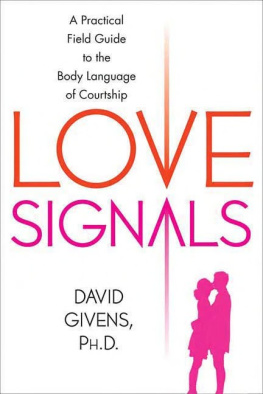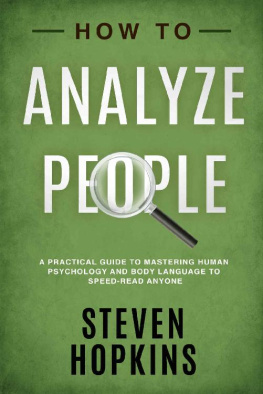I would like to thank my colleagues in anthropology, archaeology, biology, linguistics, neuroscience, psychology, semiotics, and sociology, whose research has contributed to the scientific study of courtship presented in Love Signals . I would like to thank my literary agent, Eileen Cope of Lowenstein-Yost Associates in New York, for her help and encouragement on this project. Special thanks go to my editor at St. Martins Press, Diane Reverand, for her enthusiasm and guidance, and to her editorial assistant, Regina Scarpa, for her persistence and patience.
MARIANNE: Oh, come on, Professor. These are just normal American kids.
PROFESSOR: American, yes. Normal, no. Marianne, theyre a true subculture.
BEACH PARTY (1963)
In the 1963 musical Beach Party , actor Robert Cummings plays a bearded anthropologist who studies the dating rituals of Southern Californias surfing enthusiasts, which he likens to the mating rites of the North American whooping crane. When not spying through a telescope, he uses a method called participant observation to court the leading lady, played by Annette Funicello, in an experiment to see how the leading man, Frankie Avalon, will react.
Beach Party opens with Dolores (Funicello) and Frankie driving to the beach for what he thinks will be a romantic vacation for two. Fearful of what might happen, Dolores secretly invites their surfer friends along to keep them company. Angered by her deception, Frankie flirts with another woman to make Dolores jealous. When Dolores retaliates by flirting with Professor Robert Sutwell (Cummings), Frankies plan backfires.
Beach Party was first in a series of movies set on California beaches to depict the clothing, hairstyles, language, music, and wild, gyrating dances of the indigenous surfing scene. The movie was very unscientific and all in fun.
As a freshman majoring in anthropology at San Diego State College,I couldnt have known that I would one day become an anthropologist who would study the body language of courtship. Nor would I have believed that so much of what I had seen in Beach Party was true. The professors comparison of surfers to whooping cranes, for instance, has a factual basis in biology. Much of our courtship is rooted in the evolution of vertebrates. To lure a mate, we use many of the same body movements, gestures, and postures used by reptiles, mammals, and birds.
A case in point is dance. Whooping cranes court by flapping their wings, bowing their heads, and leaping into the air. The male struts in a high-stepping gait, stomps his feet, tosses his head, and ruffles his feathers to say Look at me! An interested female imitates his body movements, dances a duet beside him, bows as he bows, and tosses a twig into the air with her bill. On the beach, nocturnal surfers dance, pump their elbows and arms in unison, rachet their shoulders in tandem, shake their heads, and stamp their feet. They make rhythmic, bowing motions from the waist toward each other to invite physical closeness.
Through a nonverbal lens, the courtship of birds and human beings looks much the same. Both send and receive body-language cues that enable them to move closer together in space. In humans, we call these nonverbal gestures, postures, facial expressions, and clothing cues love signals.
Love Signals
Love Signals begins with a look at the five phases of courtship. In Phase One, Attracting Attention, you advertise your physical presence, your gender, and your willingness to be approached. In Phase Two, the Recognition Phase, you read how others respond to your bids for attention. Positive feedback invites you ahead to Phase Three, Speech. As you speak, nonverbal messages go back and forth inviting youcloserif all goes wellto Phase Four. In the fourth or Touch Phase, you transcend the logic of words and communicate in a more ancient and more romantic, tactile mode. Finally, if courtship is successful, you validate your sexual bond in Phase Five, Lovemaking. Love Signals details the nonverbal signs, signals, and cues you send and receive in each of courtships five phases.
Next, I examine the essential role your face plays in courtship. You will learn how your features may be optimally displayed. I then decode the language of your body to find silent messages given off by your shoulders, neck, arms, hands, waist, calves, ankles, feet, and toes. Since your body is usually clothed, we will analyze expressive shapes, colors, and markings encoded in arm wear, shoulder wear, leg wear, and shoes. We decipher background messages of spaces, places, and interiorsthe physical settings in which you meetto learn how environs help or hinder the meeting process. Chemical cues emanating from aromas, tastes, steroids, sterols, and hormones strongly shape your partners feelings, so we will explore these invisible signs as well.
Much of what Love Signals reports derives from field observations. After receiving my Ph.D. in anthropology from the University of Washington, I immersed myself in singles culture and watched as men and women fumbled to connect at parties, in coffeehouses, and in bars. Observing covertly from behind the potted palm, I became what French anthropologist Claude Lvi-Strauss has called the alienated eye-witness. I found a universal pattern in the way couples related, nonverbally, beneath spoken words. Whether one lives in New Delhi, New Guinea, or New York, the same body language is used to attract a mate. In Love Signals , I will tell you what I have learned.
The study of body language is more scientific now than it has been in the past. In the 1960s, some viewed nonverbal communication as little more than a subjective branch of phrenology. Advances in neuroscience, evolutionary biology, and emotion research have made body language a scientifically credible field today. Researchers havemapped the precise neural pathways that link nonverbal signals to the nervous system. What this means for courtship is that you can read unspoken motives, emotions, and feelings with greater clarity and precision.
Love Signals is part ethnography and part how-to. It documents the little courting rituals you see in elevators, on subways, and in the workplace. It suggests ways to gaze, ways to read eyes across a room, and ways to sit, stand, align, walk, dress, and lift a drink to participate in the fascinating adventure of finding, winning, and keeping a mate. Knowing the unspoken vocabulary of love signals gives you an edge. The more you know about the nonverbal idiom of attraction, the more likely you will find a loving, lasting partner. Have fun observing, and enjoy the quest!
Once Im done with kindergarten, Im going to find me a wife.
TOM(AGE 5 )
Its better to be looked over than overlooked.
MAE WEST
L OVE SIGNALS IS a practical field guide to the body language of courtship. It explores the nonverbal signs, signals, and cues human beings exchange to attract and keep their mates. As a medium of communication, loves silent language predates speech by millions of years. Indeed, humans wooed in a nonverbal idiom well before they could speak. And today, despite the worlds estimated six thousand spoken languages, we still express emotions and feelings largely apart from words.
The first scientific study of courtship in our species, Homo sapiens, took place in the 1960s. Using a camera with mirror lenses to film couples without disturbing them, biologist Irenus Eibl-Eibesfeldt of Germanys Max Planck Institute documented many of the common flirting rituals seen around the world. A student of Konrad Lorenz, Eibl-Eibesfeldt wrote his doctorate, Breeding Biology of the Common Toad, before turning his lenses on human beings. From research in Brazil, Samoa, Paris, and other exotic field sites, Eibl-Eibesfeldt discovered a universal vocabulary of nonverbal signs used in seduction, flirtation, and courtship.









